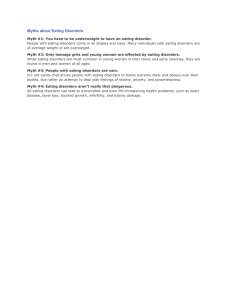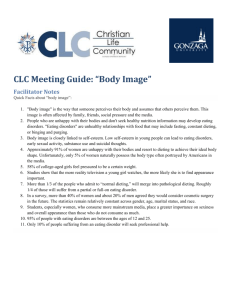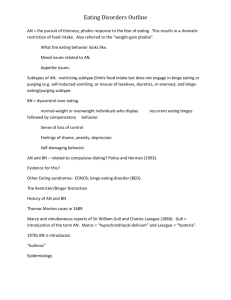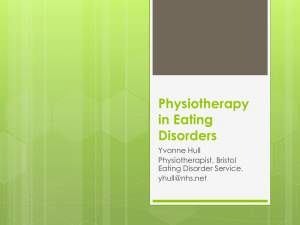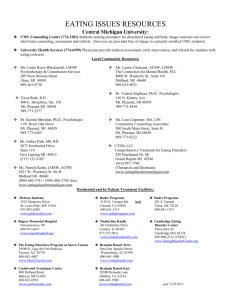Dying to Be Thin: Changes in the Perception of
advertisement
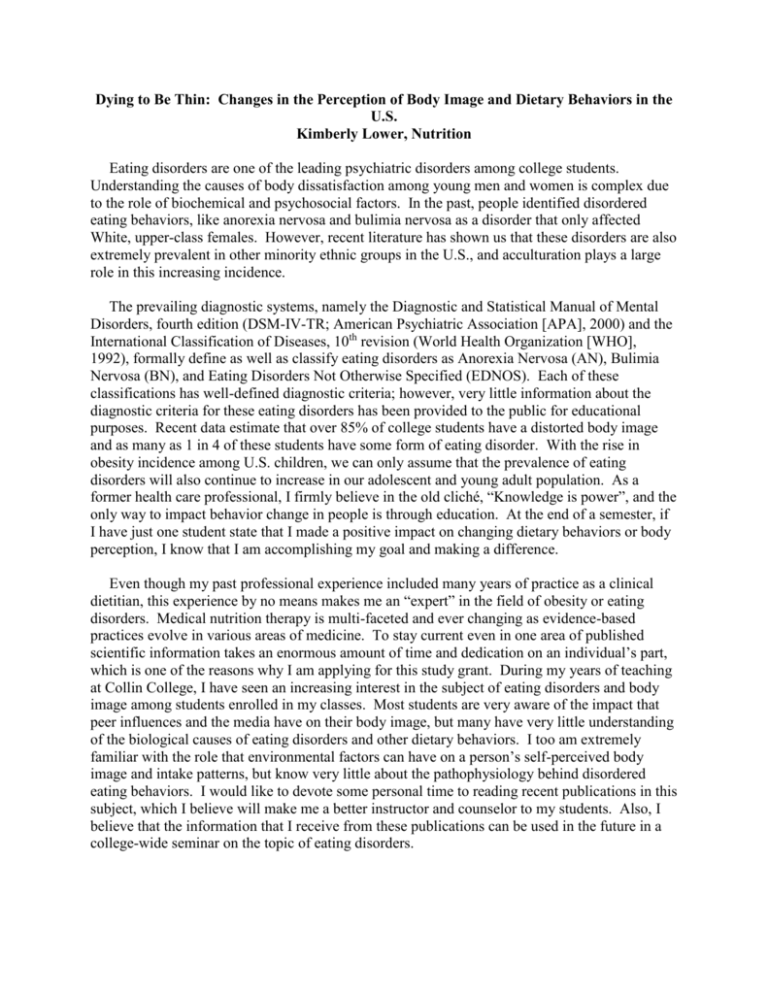
Dying to Be Thin: Changes in the Perception of Body Image and Dietary Behaviors in the U.S. Kimberly Lower, Nutrition Eating disorders are one of the leading psychiatric disorders among college students. Understanding the causes of body dissatisfaction among young men and women is complex due to the role of biochemical and psychosocial factors. In the past, people identified disordered eating behaviors, like anorexia nervosa and bulimia nervosa as a disorder that only affected White, upper-class females. However, recent literature has shown us that these disorders are also extremely prevalent in other minority ethnic groups in the U.S., and acculturation plays a large role in this increasing incidence. The prevailing diagnostic systems, namely the Diagnostic and Statistical Manual of Mental Disorders, fourth edition (DSM-IV-TR; American Psychiatric Association [APA], 2000) and the International Classification of Diseases, 10th revision (World Health Organization [WHO], 1992), formally define as well as classify eating disorders as Anorexia Nervosa (AN), Bulimia Nervosa (BN), and Eating Disorders Not Otherwise Specified (EDNOS). Each of these classifications has well-defined diagnostic criteria; however, very little information about the diagnostic criteria for these eating disorders has been provided to the public for educational purposes. Recent data estimate that over 85% of college students have a distorted body image and as many as 1 in 4 of these students have some form of eating disorder. With the rise in obesity incidence among U.S. children, we can only assume that the prevalence of eating disorders will also continue to increase in our adolescent and young adult population. As a former health care professional, I firmly believe in the old cliché, “Knowledge is power”, and the only way to impact behavior change in people is through education. At the end of a semester, if I have just one student state that I made a positive impact on changing dietary behaviors or body perception, I know that I am accomplishing my goal and making a difference. Even though my past professional experience included many years of practice as a clinical dietitian, this experience by no means makes me an “expert” in the field of obesity or eating disorders. Medical nutrition therapy is multi-faceted and ever changing as evidence-based practices evolve in various areas of medicine. To stay current even in one area of published scientific information takes an enormous amount of time and dedication on an individual’s part, which is one of the reasons why I am applying for this study grant. During my years of teaching at Collin College, I have seen an increasing interest in the subject of eating disorders and body image among students enrolled in my classes. Most students are very aware of the impact that peer influences and the media have on their body image, but many have very little understanding of the biological causes of eating disorders and other dietary behaviors. I too am extremely familiar with the role that environmental factors can have on a person’s self-perceived body image and intake patterns, but know very little about the pathophysiology behind disordered eating behaviors. I would like to devote some personal time to reading recent publications in this subject, which I believe will make me a better instructor and counselor to my students. Also, I believe that the information that I receive from these publications can be used in the future in a college-wide seminar on the topic of eating disorders. If I am awarded this grant, I will begin my study of the literature pertaining to cultural changes that have occurred over recent decades in the U.S. Specifically, “What role has the American culture had on the self-perceived body image and dietary intake behaviors of people in the U.S?” In the past, intelligence, spirituality, charity and volunteerism, and skills for all things domestic were once revered. The most popular girl in her class wasn't always the prettiest girl. The girl considered best for marriage had the qualities desired for a wife and mother and not what she looked like on her husband's arm. I chose the following eight books because the authors try to give some insight as to how and why gender “ideals” related to body weight has evolved to today’s standards. Below is an outline of the texts to be read in the first five weeks of the summer session: Week 1: Brumberg JJ. The Body Project: An Intimate History of American Girls. 1st ed. New York, NY: Random House, Inc. 1997. Week 2: Grogan S. Body Image: Understanding Body Dissatisfaction in Men, Women, and Children. 1st ed. New York, NY: Routledge Press; 1998. Nasser M. Culture and Weight Consciousness. 1st ed. New York, NY: Routledge Press; 1997. Week 3: Braziel JE, LeBesco K, eds. Bodies Out of Bounds: Fatness and Transgression. Berkeley and Los Angeles, CA: University of California Press; 2001. Week 4: Stearns P. Fat History: Bodies and Beauty of the Modern West. 2nd ed. New York, NY: NYU Press; 2002. Week 5: Bordo S. Unbearable Weight: Feminism, Western Culture, and the Body. 2nd ed. Berkeley and Los Angeles, CA: University of California Press; 2004. Second, I would like to address the question, “Are disordered eating behaviors learned or are they biological?” Many researchers believe that disordered eating behaviors stem from certain genetic factors and other underlying neurobiological imbalances. Therefore, in addition to the three books listed below that pertain to information about the history of eating disorders, I feel it would be beneficial to review through some of the most recent research publications that provide information on the biological and environmental factors associated with eating disorders. My literature search in Medline includes both original and meta-analysis articles for review. Week 6: Brumberg JJ. Fasting Girls: The History of Anorexia Nervosa. 1st ed. New York, NY: Random House, Inc.; 2000. 2 Week 7: Gordon R. Eating Disorders: Anatomy of a Social Epidemic. 2nd ed. Malden, MA: Blackwell Publishers; 2000. Week 8: Bulik CM, Hebebrand J, Keski-Rahkonen A, Klump KL, Reichborn-Kjennerud T, Mazzeo SE, Wade TD. Genetic epidemiology, endophenotypes, and eating disorder classification. Int J Eat Disord. 2007; 40:S52-60. Elfhag K, Linné Y. Gender differences in associations of eating pathology between mothers and their adolescent offspring. Obes Res. 2005;13:1070-6. Gratacòs M, González JR, Mercader JM, de Cid R, Urretavizcaya M, Estivill X. Brain-derived neurotrophic factor Val66Met and psychiatric disorders: meta-analysis of case-control studies confirm association to substance-related disorders, eating disorders, and schizophrenia. Biol Psychiatry. 2007; 61:911-22. Grunstein WR, Clark M. The Genetics of Consumption, Part I: Eating Disorders. In: Are We Hardwired? The Role of Genes in Human Behavior. 1st ed. New York, NY: Oxford University Press, USA; 2000. Halmi KA, Tozzi F, Thornton LM, Crow S, Fichter MM, et al. The relation among perfectionism, obsessive-compulsive personality disorder and obsessive-compulsive disorder in individuals with eating disorders. Int J Eat Disord. 2005; 38:371-4. Klump KL, Burt SA, McGue M, Iacono WG. Changes in genetic and environmental influences on disordered eating across adolescence: a longitudinal twin study. Arch Of Gen Psych. 2007; 64:1409-15. Klump KL, Wonderlich S, Lehoux P, Lilenfeld LR, Bulik CM. Does environment matter? A review of nonshared environment and eating disorders. Int J Eat Disord. 2002; 31:118-35. Monteleone P, DiLieto A, Castaldo E, Maj M. Leptin functioning in eating disorders. CNS Spectr. 2004; 9:523-9. Park RJ, Senior R, Stein A. The offspring of mothers with eating disorders. Eur Child Adolesc Psychiatry. 2003; 12:I110-19. Rankinen T, Bouchard C. Genetics of food intake and eating behavior phenotypes in humans. Annu Rev Nutr. 2006; 26:413-34. Steiger H, Bruce KR. Phenotypes, endophenotypes, and genotypes in bulimia spectrum eating disorders. Can J Psychiatry. 2007; 52:220-7. 3 Woodside DB, Bulik CM, Halmi KA, Fichter MM, Kaplan A; et al. Personality, perfectionism, and attitudes toward eating in parents of individuals with eating disorders. Int J Eat Disord. 2002; 31:290-9. Ziegler A, Hebebrand J, Görg T, Rosenkranz K, Fichter M, et al. Further lack of association between the 5-HT2A gene promoter polymorphism and susceptibility to eating disorders and a meta-analysis pertaining to anorexia nervosa. Mol Psychiatry. 1999; 4:410-2. 4




